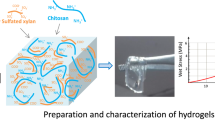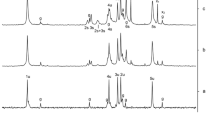Abstract
Xylan is a highly available polysaccharide in the plant kingdom and is therefore a valuable resource for novel materials from renewable resources. Hydroxyalkylation is one of the most common reactions to derivatize biopolymers by altering hydroxyl groups. State of the art procedures incorporate epoxides, which are toxic, carcinogenic and highly explosive. In this study, hydroxyalkylation with propylene carbonate (PC) was used as green approach to synthesize xylan derivatives. Reaction pathways under homogeneous conditions, in dimethyl sulfoxide (DMSO), and heterogeneous conditions, without solvent, are compared. Analysis using liquid state and high resolution magic angle spinning (HRMAS) NMR, a novel approach for insoluble but swellable polysaccharide derivatives, as well as FTIR spectroscopy, hydrolysis in combination with borate anion exchange chromatography, and rheology showed significant differences regarding the structure of the products. While the degree of substitution (DS) is similar under both conditions, side chains are significantly longer under heterogeneous conditions, implying a higher rate of homopolymerization. This leads to a non-complete decarboxylation. The higher sterical hindrance imposed by longer side chains therefore leads to a higher tendency of xylose monosaccharides being derivatized at only one native hydroxyl group, while under homogeneous conditions a higher tendency towards double substitution can be observed. Rheology showed a shear thinning behaviour as well as an increase in viscosity with DS for samples from homogeneous synthesis. Products from solvent-free approach were analyzed in swollen state. They showed gel-like behaviour, whose elasticity increases with increasing DS as a result of side chain entanglement.










Similar content being viewed by others
References
Akil Y, Lorenz D, Lehnen R, Saake B (2016a) Safe and non-toxic hydroxyalkylation of xylan using propylene carbonate. Eur Polym J 77:88–97. https://doi.org/10.1016/j.eurpolymj.2016.02.010
Akil Y, Lehnen R, Saake B (2016b) Novel synthesis of hydroxyvinylethyl xylan using 4-vinyl-1,3-dioxolan-2-one. Tetr Lett 57:4200–4202. https://doi.org/10.1016/j.tetlet.2016.08.009
Alam TM, Jenkins JE (2012) HR-MAS NMR spectroscopy in material science. In: Farrukh MA (ed) Advanced aspects of spectroscopy, edited volume. InTech, Rijeka, pp 279–306. https://doi.org/10.5772/2757
Arbenz A, Avérous L (2015) Oxyalklyation of gambier tannin–synthesis and characterization of ensuing biobased poylols. Ind Crop Prod 67:295–304. https://doi.org/10.1016/j.indcrop.2015.01.073
Bohrisch J, Vorwerg W, Radosta S (2004) Development of Hydrophobic Starch. Starch 56:322–329. https://doi.org/10.1002/star.200300267
Clements JH (2003) Reactive applications of cyclic alkylene carbonates. Ind Eng Chem Res 42:663–674. https://doi.org/10.1021/ie020678i
Cunha AG, Gandini A (2010) Turning polysaccharides into hydrophobic materials: a critival review. Part 2. Hemicelluloses, chitin/chitosan, starch, pectin and alginates. Cellulose 17:1045–1065. https://doi.org/10.1007/s10570-010-9435-5
Database SciFinder–A CAS Solution. http://www.cas.org/products/scifinder. Accessed 10 July 2017
de Menezes AJ, Pasquini D, da Silva Curvelo AA, Gandini A (2007) Novel thermoplastic materials based on the outher-shell oxypropylation of corn starch granules. Biomacromol 8:2049–2050. https://doi.org/10.1021/bm070389j
de Menezes AJ, Pasquini D, da Silva Curvelo AA, Gandini A (2009) Self-reinforced composites obtained by the partial oxypropylation of cellulose fibers 1. Characterization of the materials obtained with different types of fibers. Carbohydr Polym 76:437–442. https://doi.org/10.1016/j.carbpol.2008.11.006
Duval A, Avérous L (2016) Oxyalkylation of condensed tannin with propylene carbonate as an alternative to propylene oxide. ACS Sustain Chem Eng 4:3103–3112. https://doi.org/10.1021/acssuschemeng.6b00081
Duval A, Avérous L (2017) Solvent- and halogen-free modification of biobased polyphenols to introduce vinyl groups: versatile aromatic building blocks for polymer synthesis. Chem Sus Chem 10:1813–1822. https://doi.org/10.1002/cssc.201700066
Ebringerová A (2005) Structural diversity and application potential of hemicelluloses. Macromol Symp 232:1–12. https://doi.org/10.1002/masy.200551401
Ebringerová A, Heinze T (2000) Xylan and xylan derivatives–biopolymers with valuable properties 1. Naturally occurring xylans structures, isolation procedures and properties. Macromol Rapid Commun 21:542–556. https://doi.org/10.1002/1521-3927(20000601)21:9<542:AID-MARC542>3.0.CO;2-7
Fernandes S, Freire CSR, Neto SP, Gandini A (2008) The bulk oxypropylation of chitin and chitosan and the characterization of the ensuing polyols. Green Chem 10:93–97. https://doi.org/10.1039/B711648A
Gandini A, da Silva Curvelo AA, Pasquini DP, de Menezes AJ (2005) Direct transformation of cellulose fibres into self-reinforced composites by partial oxypropylation. Polymer 49:10611–10613. https://doi.org/10.1016/j.polymer.2005.09.004
García DE, Glasser WG, Pizzi A, Osorio-Madrazo A, Laborie MP (2013) Hydroxypropyl tannin derivatives from Pinus pinaster (Ait.) bark. Ind Crop Prod 49:730–739. https://doi.org/10.1016/j.indcrop.2013.06.019
Gil AM, Duarte IF, Delgadillo I, Colguhoun IJ, Casuscelli F, Humpfer E, Spraul M (2000) Study of the compositional changes of mango during ripening by use of nuclear magnetic resonance spectroscopy. J Agric Food Chem 48:1524–1536. https://doi.org/10.1021/jf9911287
Glasser WG, Leitheiser RH (1984) Engineering plastics from lignin. Polym Bull. https://doi.org/10.1007/BF00258264
Jain RK, Sjöstedt M, Glasser WG (2000) Thermoplastic xylan derivatives with propylene oxide. Cellulose 7:319–336. https://doi.org/10.1023/A:1009260415771
Kühnel I, Podschun J, Saake B, Lehnen R (2015) Synthesis of lignin polyols via oxyalkylation with propylene carbonate. Holzforschung 69:531–538. https://doi.org/10.1515/hf-2014-0068
Kühnel I, Saake B, Lehnen R (2017a) Oxyalkylation of lignin with propylene carbonate: influence of reaction parameters on the ensuing bio-based polyols. Ind Crop Prod 101:75–83. https://doi.org/10.1016/j.indcrop.2017.03.002
Kühnel I, Saake B, Lehnen R (2017b) Comparison of different cyclic organic carbonates in the oxyalkylation of various types of lignin. React Funct Polym 120:83–91. https://doi.org/10.1016/j.reactfunctpolym.2017.09.011
Laine C, Harlin A, Jartman J, Hyvärinen S, Kammiovirta K, Krogerus B, Pajari H, Rautkoski H, Setälä H, Sievänen J, Uotila J, Vähä-Nissi M (2013) Hydroxyalkylated xylans–their synthesis and application in coatings for packaging and paper. Ind Crop Prod 44:692–704. https://doi.org/10.1016/j.indcrop.2012.08.033
Lorenz D, Erasmy N, Akil Y, Saalke B (2016) A new method for the quantification of monosaccharides, uronic acids and oligosaccharides in partially hydrolyzed xylans by HPAEC-UV/VIS. Carbohydr Polym 140:181–187. https://doi.org/10.1016/j.carbpol.2015.12.027
Luby P, Kuniak L, Fanter C (1979) Crosslinking statistics, 3. Relation between relative reactivity and accessibility of cellulose hydroxyl groups. Makromolekul Chem 180:2379–2386. https://doi.org/10.1002/macp.1979.021801012
Martins JC, Mercier FAG, Vancervelden A, Biesemans M, Wieruszeski JM, Humpfer E, Willem R, Lippens G (2002) Fine-tuned characterization at the solid/solution interface of organotin compounds grafted onto cross-linked polystyrene by using high-resolution MAS NMR spectroscopy. Chem Eur J 8:3431–3441. https://doi.org/10.1002/1521-3765(20020802)8:15<3431:AID-CHEM3431>3.0.CO;2-6
Meissner A, Bloch P, Humpfer E, Spraul M, Sørensen OW (1997) Reduction of inhomogeneous line broadening in two-dimensional high-resolution MAS NMR spectra of molecules attached to swelled resins in solid-phase synthesis. J Am Chem Soc 199:1787–1788. https://doi.org/10.1021/ja9630001
Mikkonen KS, Laine C, Kontro I, Talja RA, Serimaa R, Tenkanen M (2015) Combination of internal and external plasticization of hydroxypropylated birch xylan tailors the properties of sustainable barrier films. Eur Polym J 66:307–318. https://doi.org/10.1016/j.eurpolymj.2015.02.034
Nadji H, Bruzzèse C, Belgacem MN, Benaboura A, Gandini A (2005) Oxypropylation of lignins and preparation of rigid polyurethane foams from the ensuing polyols. Macromol Mater Eng 290:1009–1016. https://doi.org/10.1002/mame.200500200
Nomura R, Ninagawa A, Matsuda H (1980) Synthesis of cyclic carbonates from carbon dioxide and epoxides in the presence of organoantimony compounds as novel catalysts. J Org Chem 45:3735–3738. https://doi.org/10.1021/jo01307a002
Pavier C, Gandini A (2000) Oxypropylation of sugar beet pulp 1. Optimisation of the reaction. Ind Crop Prod 12:1–8. https://doi.org/10.1016/S0926-6690(99)00039-4
Pitkänen L, Aseyev V, Laine C, Tuomainen P, Tenkanen M (2017) Size-exclusion chromatography of xylan derivatives–the critical evaluation of macromolecular data. Anal Bioanal Chem. https://doi.org/10.1007/s00216-017-0424-5
Pope BG (1984) Hydroxyalkylation of polysaccharides. U S Pat 4(474):951
Prade RA (1996) Xylanases: from biology to biotechnology. Biotechnol Genet Eng Rev 13:101–131. https://doi.org/10.1080/02648725.1996.10647925
Rokicki G, Kowalczyk T (2000) Synthesis of oligocarbonate diols and their characterization by MALDI-TOF spectrometry. Polymer 41:9013–9031. https://doi.org/10.1016/S0032-3861(00)00273-1
Saake B, Erasmy N, Kruse T, Schmekal E, Puls J (2003) Isolation and characterization of arabinoxylan from oat spelts. In: Gatenholm P, Tenkanen M (eds) Hemicelluloses: science and technology, 1st edn. American Chemical Society, Washington, DC, pp 52–65
Schäffner B, Verevkin SP, Börner A (2009) Organische carbonate. Grüne lösungsmittel für synthese und katalyse. Chem Unserer Zeit 43:12–21. https://doi.org/10.1002/ciuz.200900468
Simpson AJ, Kingery WL, Shaw DR, Spraul M, Humpfer E, Dvortsak P (2001) The application of 1H HR-MAS NMR spectroscopy for the study of structures and associations of organic components at the solid–aqueous interface of a whole soil. Environ Sci Technol 35:3321–3325. https://doi.org/10.1021/es010607v
Sitter B, Sonnewald U, Spraul M, Fjösne HE, Gribbestad IS (2002) High-resolution magic angle spinning MRS of breast cancer tissue. NMR Biomed 15:327–337. https://doi.org/10.1002/nbm.775
Sitter B, Lundgren S, Bathen TF, Halgunset J, Fjosne HE, Gribbestad IS (2006) Comparison of HR MAS MR spectroscopic profiles of breast cancer tissue with clinical parameters. NMR Biomed 19:30–40. https://doi.org/10.1002/nbm.992
Spiridon I, Popa VI (2008) Hemicelluloses: major sources, properties and applications. In: Belgacem MN, Gandini A (eds) Monomers, polymers and composites from renewable resources, 1st edn. Elsevier Science, Amsterdam, pp 289–304
Thyrion FC, Debecker G (1973) Thermolysis of dimethyl sulfoxide. Int J Chem Kinet 5:583–592. https://doi.org/10.1002/kin.550050409
Tomczyk KM, Guńka PA, Parzuchowski PG, Zachara J, Rokicki G (2012) Intramolecular etherification of five-membered cyclic carbonates bearing hydroxyalkyl groups. Green Chem 14:1749–1758. https://doi.org/10.1039/C2GC35265F
Acknowledgments
The authors would like to acknowledge WoodWisdom Net + , the German funding agency Fachagentur Nachwachsende Rohstoffe (Ref. No. 2202214), the Bundesministerium für Ernährung und Landwirtschaft and the Ministère de l’agriculture, de l’agroalimentaire et de la forêt for funding AEROWOOD project. Additionally the authors would like to acknowledge COST FP1205 for granting a short term scientific mission (STSM) to Youssef Akil. Furthermore Bernhard Ziegler from Thünen Institute for Wood Research for HRMAS NMR measurements and Nicole Erasmy from University of Hamburg for Borate-HPAEC measurements are gratefully acknowledged.
Author information
Authors and Affiliations
Corresponding author
Electronic supplementary material
Below is the link to the electronic supplementary material.
Rights and permissions
About this article
Cite this article
Akil, Y., Castellani, R., Lehnen, R. et al. Hydroxyalkylation of xylan using propylene carbonate: comparison of products from homo- and heterogeneous synthesis by HRMAS NMR and rheology. Cellulose 25, 217–231 (2018). https://doi.org/10.1007/s10570-017-1583-4
Received:
Accepted:
Published:
Issue Date:
DOI: https://doi.org/10.1007/s10570-017-1583-4




